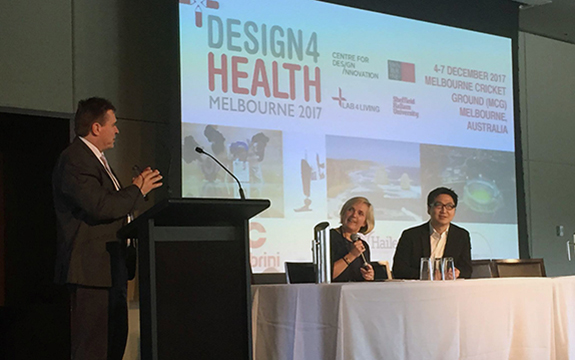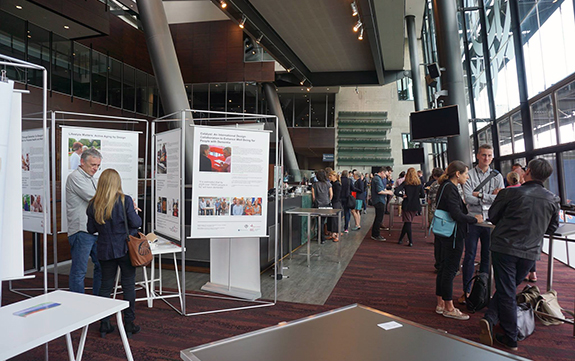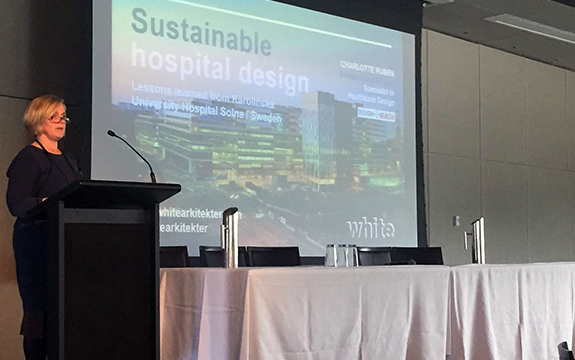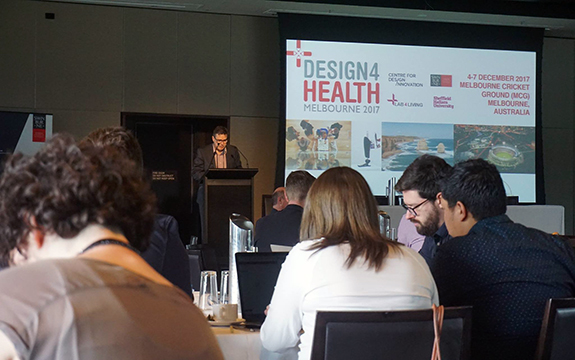Design and health researchers meet at Design4Health

In Summary
- Researchers at the cutting-edge of design and medical science presented their findings at Design4Health
- New designers recognised for fresh insights in health
The Design4Health Conference hosted by Swinburne’s Centre for Design Innovation (CDI), in partnership with the Lab4Living at Sheffield Hallam University, highlighted an important nexus forming at the forefront of medical and design research.
International researchers at the cutting-edge of design and medical science joined forces to present their findings at the annual event. Over three days, 19 countries were represented, with 122 participants, 95 presentations, 81 peer review papers and multiple exhibits in a dedicated exhibition space.

Exhibition space at the D4H event.
Design4Health or D4H is an event and journal championed by Sheffield Hallam University. The conference, held in Melbourne and hosted by CDI, was a first for the southern hemisphere.
CDI’s strong representation in research pertaining to products, services and environments to improve human health and well-being meant it was a perfect fit.
“We are working in a new exciting field where architectural, product and service design researchers are starting to converse with their counterparts in medical and allied health research,” says Professor Kurt Seemann, CDI Founding Director.
“Linking medical and design research is an interesting proposition, especially with new technologies and the opportunities to apply these to solve problems in the health and well-being sector.
New designers recognised for fresh insights in health
“Historically, designers were not active in scientific and empirical research. However, the new designers and design researchers now flowing out of universities are being recognised for the fresh and significant insights they are injecting into the health sector everywhere, from the design of innovative assistive devices, and health staff and patient environments, to hospital design,” Seemann explains.
“What designers now bring is a keen insight into how people engage with the design of the made-world around them, in them, and for them.”
The D4H event focused on design and health research approaches and the emerging interest in raising the prospect of improving speed of recovery and avoiding degree of burden, with design involved at the outset and throughout projects.

Keynote speaker at the conference, Professor Charlotte Ruben.
Keynote speaker, Professor Charlotte Ruben, architect and partner at White Arkitekter, Sweden, is frequently engaged in the ongoing debate about sustainable and holistic solutions for new healthcare buildings in Sweden.
Professor Ruben highlighted the importance of understanding experience, in particular the experience of patients in hospitals, to improve health and create positive outcomes.

Speaker Peter Gambell presenting his work on productive pathology lab systems.
Peter Gambell, Principal Scientist of Haematopathology and the Deputy Operations Director of the Pathology Department at the Peter MacCallum Cancer Centre in Melbourne, recently project managed the relocation of the pathology department at the Peter MacCallum Cancer Centre to the new Victorian Comprehensive Cancer Centre in Parkville. Mr Gambell presented his work in making pathology lab systems more productive.
“The common thread through D4H proceedings was that health service, environments, and devices, needs to understand the human experiences they are meant to support,” Professor Seemann says.
The next D4H Conference will return to the northern hemisphere in the UK, hosted by Sheffield Hallam University.

